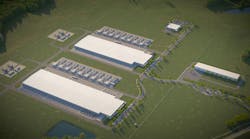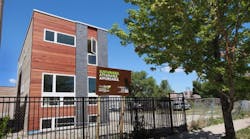Green building practices have become a fixture in the construction market, but advocates say the shift to greener buildings is underperforming its potential. The key to more widespread adoption of green buildings may lie in simpler certification processes and better data on the benefits to the builder or owner.
Although the construction of greener buildings has grown to 4,500 to 5,000 projects per year, advocates see a plateau and are looking for ways to get past it. Green-certified projects represent just 0.1% of total U.S. commercial building stock, according to some estimates, and the share of green projects is not growing enough to meet the green-building organizations’ shared goal of transforming the nation’s built environment.
To get past the plateau, advocates of green building practices are looking for better certification systems and better data with which to persuade developers. Jerry Yudelson, president of the Green Building Initiative (GBI), Portland, Ore., wrote an article last week for the Seattle Daily Journal of Commerce that looked at the conundrum of how to get green principles integrated in more buildings.
Yudelson, who will be familiar to many in the electrical industry from past years of NAED conference seminars on green building while he led his own consulting firm, says a big part of the issue is the cost and complexity of complying with the largest and most visible of the green-building certification options, the U.S. Green Building Council’s Leadership in Energy and Environmental Design (LEED) program. Yudelson spent 15 years promoting the LEED system as a trainer and consultant.
He sees LEED’s success in large-scale and high-profile office buildings and corporate real estate, but this has left out the majority of the nation’s building stock of small offices, K-12 schools, most universities and almost all retail stores. The reason, Yudelson says, is that perceived benefits don’t measure up to the actual costs of certification.
“Perceived benefits are slight: In most cases, the benefits include savings in energy efficiency that would be achieved in most cases without a green building certification, claims for improved employee health and productivity backed by weak empirical evidence, and better PR and marketing benefits for developers, etc.,” Yudelson wrote.
“Costs are real: Just the required commissioning services in LEED can add $0.50-$1 per square foot to the cost of a building. Add in the consulting costs, which can easily run into six figures, and one begins to understand why for most owners and developers pursuing green building certification, unless mandated by policy or driven by government incentives, is something for which they are increasingly saying deciding, ‘no thanks.’”
Yudelson proposes a three-point solution: 1) lowering the cost of certification compliance, 2) simplifying the criteria to focus on the three areas with the most impact — energy, water and waste — and 3) putting performance measures in an easy-to-access cloud-based reporting environment.
It’s just this kind of streamlining and accountability that his organization, GBI, is set up to provide, and its Green Globes certification is catching on as an alternative to LEED, though it still toils in LEED’s shadow. Instead of LEED’s silver-gold-platinum rating levels, a green building is awarded a number of Green Globes corresponding to the measures taken to reduce the building’s environmental impact. Two Green Globes is roughly equivalent to LEED Silver.
The U.S. General Services Administration (GSA) in 2013 gave the GBI a helpful shot of recognition when it recommended that federal sustainability projects use either LEED or Green Globes standards. The U.S. Department of Energy (DOE) added to that momentum last fall when it ruled that federal agencies must meet the equivalent of LEED Silver or two Green Globes for new construction or major renovations.
An article in the Feb. 2015 issue of Engineering News Record (ENR) found one project, a new science building at Drexel University, Philadelphia, where the builder sought certifications under both LEED and Green Globes. A study after the building was completed put the cost of LEED at $125,000 versus Green Globes at $9,000.
Regardless of which kind of certification a builder pursues, a more pervasive challenge arises in justifying the expense of green building at all, and more studies quantifying the financial impact of green building are needed. A 2013 study by the Institute for Market Transformation and the Appraisal Institute took a good crack at the matter, looking at the impact of green initiatives on four measures of property value: revenue, occupancy, operating expenses and risk. The report, titled “Green Building and Property Value: A primer for building owners and developers” characterized several parameters such as how green-design features like daylight and fresh air can affect rent and occupancy levels, how energy savings translate into increases in net operating income, and how green building practices can influence different approaches to property valuation by appraisers and underwriters.
By reducing the costs of green-building certifications and developing further studies on the hard dollars-and-cents benefits of green building design, construction and operations techniques, advocates hope to shift the momentum further toward making more the nation’s building stock more efficient and sustainable.









